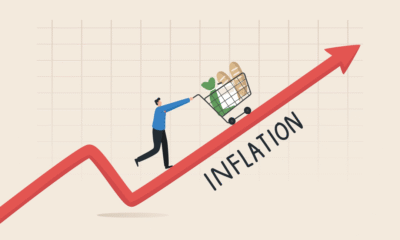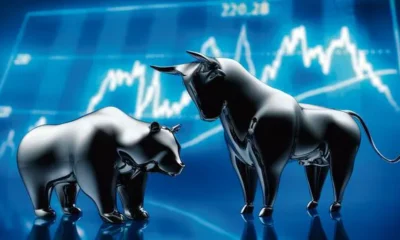Finance
Sustainable Investing: ESG Trends Shaping the Future of Finance

Introduction to Sustainable Investing
Sustainable investing has emerged as a pivotal approach within the financial industry, reflecting the growing awareness of environmental, social, and governance (ESG) factors. This investment strategy aims not only to generate financial returns but also to effect positive change in society and the environment. The significance of sustainable investing can be seen in its transformative impact on traditional financial models, aligning profit motives with ethical considerations. As investors increasingly prioritize sustainability metrics, the financial landscape is evolving rapidly.
At its core, sustainable investing encompasses various strategies that integrate ESG factors into investment decisions. Environmental considerations may include issues such as climate change, resource depletion, and pollution, influencing investors to allocate capital towards companies demonstrating environmental stewardship. Social factors address the impact of business operations on communities, which incorporates labor practices, diversity, and human rights concerns. Governance involves the systems and processes that direct and control a company, emphasizing the importance of responsible leadership and ethical practices.
The rise of sustainable investing reflects a broader shift in consumer and investor behavior, as stakeholders demand greater accountability and transparency from corporations. This trend compels companies to adopt sustainable practices, which not only enhances their reputations but also mitigates risks associated with environmental and social dilemmas. As the global economy grapples with pressing issues such as climate change and social inequality, the integration of ESG principles within investment strategies becomes increasingly essential.
This introduction sets the foundation for a detailed exploration of the trends shaping sustainable investing. Understanding the fundamental concepts and terminology associated with ESG investing will facilitate a deeper comprehension of the current landscape and the future trajectory of finance in relation to sustainability.
The Rise of ESG Investing
In recent years, the world of finance has witnessed a significant transformation, marked by the rapid ascent of Environmental, Social, and Governance (ESG) investing. This investment approach focuses on companies that prioritize sustainability and ethical practices, resonating with a growing number of investors who wish to align their financial decisions with their values. According to a report by the Global Sustainable Investment Alliance, global sustainable investment reached approximately $30 trillion in assets by 2021, representing a 34% increase from 2018. This surge indicates a robust shift in investor sentiment towards sustainable practices.
Several factors are contributing to the rise of ESG investing. Firstly, regulatory changes in various jurisdictions are playing a pivotal role. Governments and financial regulatory bodies are increasingly recognizing the importance of sustainability in economic development and are implementing policies that require greater transparency in corporate reporting of ESG factors. This regulatory landscape has created an environment that encourages investors to incorporate ESG criteria into their investment decisions.
Moreover, shifting consumer preferences are significantly influencing the growth of ESG investing. Today’s consumers, particularly millennials and Generation Z, are more aware of the impact their choices have on the environment and society. This demographic shift is prompting companies to adopt sustainable practices to attract and retain customers. As a result, investors are also keen to support businesses that demonstrate a commitment to ESG principles, thus driving increased capital towards sustainable ventures.
Additionally, social movements advocating for equity, diversity, and environmental conservation are further bolstering the ESG trend. Organizations worldwide are increasingly pressured by activists and community stakeholders to prioritize ethical practices and sustainability. This advocacy not only fosters a culture of accountability but also galvanizes investor interest in companies that embed these principles within their operational frameworks.
Overall, the rise of ESG investing signals a transformative moment in the financial sector, driven by regulatory frameworks, consumer activism, and an evolving cultural landscape that prioritizes sustainability and responsible governance.
Key ESG Trends in the Financial Sector
The financial sector is undergoing a notable transformation as Environmental, Social, and Governance (ESG) criteria become integral to investment strategies. One of the most prominent trends is the rise of green bonds, which are designed to fund projects with positive environmental impacts. These bonds enable investors to allocate capital towards renewable energy, sustainable infrastructure, and other environmentally friendly projects while garnering financial returns. According to recent studies, the issuance of green bonds has surged, reflecting a growing recognition among both investors and corporations of their role in combating climate change.
Another critical trend is impact investing, where capital is directed toward businesses and initiatives that proactively address social and environmental challenges. This approach goes beyond traditional financial returns, emphasizing measurable positive outcomes. Investment firms are increasingly seeking to incorporate measurable impact metrics into their analysis, aligning their portfolios with broader societal objectives while recognizing the long-term benefits of sustainability. This practice is fostering innovation and driving funds toward sectors such as healthcare, education, and clean energy.
The integration of ESG criteria into investment strategies is also becoming standard practice among asset managers and institutional investors. By assessing ESG factors, investors can better understand potential risks and opportunities that may not be evident through conventional financial analysis alone. This holistic approach enhances risk management and capital allocation processes, leading to more sustainable business practices. As stakeholders demand greater accountability and transparency, financial institutions are compelled to adapt to these evolving expectations. The ongoing emphasis on ESG considerations reflects a fundamental shift in the financial sector towards greater responsibility and responsiveness to societal needs.
Regulatory and Policy Developments
In recent years, the landscape of sustainable investing has been significantly influenced by an array of regulatory and policy developments. Governments and international bodies across the globe have recognized the importance of Environmental, Social, and Governance (ESG) factors in shaping corporate behavior and fostering sustainable practices. One of the most notable advancements in this area is the introduction of the EU Sustainable Finance Disclosure Regulation (SFDR), which mandates financial institutions to disclose how they integrate ESG factors into their investment processes. This regulation aims to enhance transparency and mitigate the risk of ‘greenwashing,’ thereby positioning sustainable investing as a credible alternative in the financial sector.
Moreover, globally significant policy movements, such as the Paris Agreement, have underscored the necessity for countries to commit to reducing greenhouse gas emissions. This international accord has spurred nations to create more stringent regulations targeting corporate sustainability. Examples of this can be observed in various jurisdictions, where governments are crafting policies that require large companies to report their ESG performance in measurable terms. Such legislative frameworks not only promote accountability but also enable investors to evaluate risks associated with investments in line with ESG principles.
In addition, the focus on sustainable investing has led to the rise of initiatives such as the Task Force on Climate-related Financial Disclosures (TCFD). This initiative encourages companies to disclose climate-related financial risks, providing a structured approach that investors can use to assess potential hazards associated with their portfolios. Through these regulatory measures and frameworks, there is an evident shift towards fostering trust in sustainable investments, providing investors with the necessary information to make informed decisions while adhering to their values. Such developments are critical as they pave the way for a more resilient and sustainable financial system.
Challenges of Implementing ESG Strategies
As sustainable investing gains momentum, investors and companies alike face numerous challenges in effectively implementing Environmental, Social, and Governance (ESG) strategies. One significant hurdle is the inconsistency of data. The lack of standardized metrics for assessing ESG performance can lead to discrepancies in reporting, making it difficult for investors to compare different companies accurately. This inconsistency complicates the investment decision-making process, as investors rely on transparent and reliable data to inform their strategies.
Another critical challenge is greenwashing, a term that describes the practice where companies exaggerate or falsely claim to be environmentally friendly. This deceptive marketing undermines the credibility of genuine sustainable investing efforts and makes it more challenging for investors to identify truly responsible companies. Greenwashing not only misleads investors but also diverts attention and resources away from authentic ESG initiatives, hindering overall progress in sustainable practices. Investors must remain vigilant, scrutinizing corporate claims and seeking third-party verification to mitigate the risks associated with greenwashing.
Additionally, measuring the actual impact of ESG strategies poses a significant challenge. Various frameworks exist for evaluating the effectiveness of ESG investments, yet no universally accepted approach exists. This lack of uniformity can result in confusion and may deter potential investors who are uncertain about the tangible benefits of ESG strategies. Evaluating the long-term impact on financial performance and societal outcomes remains a complex undertaking that requires thorough analysis and adaptation over time.
Addressing these challenges is essential for fostering a more robust sustainable investment landscape. Investors and companies must collaborate to develop standardized metrics and reporting frameworks, ensuring transparency and fostering trust. As the field evolves, embracing these complexities will enhance the effectiveness of ESG strategies and drive meaningful change in the finance industry.
The Role of Technology in Sustainable Investing
Technology plays a pivotal role in transforming the landscape of sustainable investing, particularly through advancements in Artificial Intelligence (AI) and blockchain. These innovations are not only streamlining the analysis of Environmental, Social, and Governance (ESG) data but are also enhancing the overall transparency and efficiency of the sustainable finance sector. AI algorithms have the capacity to sift through vast datasets rapidly. By utilizing machine learning techniques, these algorithms can detect patterns and correlations that human analysts might overlook, leading to more informed investment decisions that align with sustainable practices.
Moreover, AI can automate and refine the process of ESG reporting. Investors are increasingly demanding accurate and timely information about corporate sustainability practices. Through AI-driven platforms, stakeholders can receive real-time updates on a company’s performance against predefined ESG criteria. This shift fosters greater accountability for companies and facilitates investors in making choices that reflect their ethical values.
Blockchain technology, on the other hand, is revolutionizing the way transactions and data are recorded. It provides a secure and immutable ledger that can trace the sourcing of materials and track the sustainability claims of companies. For instance, companies can use blockchain to verify their supply chains, ensuring that products are sourced responsibly and ethically. This traceability not only builds trust with consumers but also promotes wider adoption of sustainable practices among businesses.
In addition to AI and blockchain, other technological advancements, such as big data analytics and cloud computing, significantly contribute to the effective measurement of ESG outcomes. These tools enable investors to analyze trends and assess the financial implications of sustainability initiatives on a broader scale. As technology continues to evolve, its integration into sustainable investing will likely lead to more strategic investments, driving positive socio-environmental change across various sectors.
Investor Perspectives on ESG
The landscape of sustainable investing has evolved significantly, with Environmental, Social, and Governance (ESG) factors becoming a pivotal aspect of investment decisions for a diverse array of investors. Institutional investors, such as pension funds and insurance companies, often adopt ESG criteria because they recognize the long-term financial benefits associated with sustainable practices. These investors are driven by a fiduciary duty to their clients, which increasingly includes considerations of sustainable performance. As regulations become more stringent and public sentiment shifts towards ethical practices, institutional investors are increasingly focusing on how ESG issues can impact risk and return profiles.
In contrast, retail investors, who traditionally may not have prioritized ESG considerations, are now expressing a growing interest in sustainable investment options. This shift is largely driven by a desire to align personal values with investment portfolios. Many retail clients are motivated by a sense of responsibility towards societal and environmental issues, expressing a preference for funds and companies that reflect their ethical considerations. Additionally, the rise of digital platforms has made ESG investing more accessible by providing educational resources and easier ways to invest in sustainable funds.
Despite these similarities, there are notable differences between institutional and retail investors regarding expected returns and investment horizons. Institutional investors typically pursue a more long-term perspective, focusing on the potential for sustained growth via ESG integration. Conversely, retail investors may prioritize immediate returns, often seeking short- to medium-term gains while still emphasizing ethical considerations. This diversity in motivations, expectations, and preferences underscores the complexity of the sustainable investment landscape. As both segments continue to expand their focus on ESG criteria, the collective impact on the financial markets is likely to be profound, influencing corporate behavior and investment trends for years to come.
Future Outlook for Sustainable Investing
The landscape of sustainable investing is poised for significant evolution, driven by a multitude of factors including market dynamics, societal expectations, and technological advancements. As environmental, social, and governance (ESG) criteria gain prominence, investors are increasingly scrutinizing the societal impact of their investment choices. This trend indicates a future where sustainable investing will not only become standard practice but also a crucial criterion for performance evaluation in finance.
One prominent trend is the growing integration of sustainability metrics into financial reporting. Regulatory bodies across the globe are pushing for more transparency in ESG disclosures. Companies that embrace this demand may significantly enhance their appeal to a broader base of investors. As investors become more informed about the environmental and social implications of their investments, firms that prioritize sustainable practices are expected to outperform their less sustainable counterparts.
Moreover, technological advancements are playing a pivotal role in the transformation of sustainable investing. The rise of fintech solutions has enabled investors to access a wealth of data on company practices and their impacts. Artificial intelligence and big data analytics are being utilized to assess ESG performance comprehensively and accurately. This capability not only facilitates better investment decisions but also empowers shareholders to engage more effectively with corporations about sustainability practices.
Culturally, there is a notable shift in societal expectations regarding corporate responsibility. Younger generations are increasingly prioritizing sustainability. This demographic is likely to drive market change, pushing companies towards adopting more sustainable practices as they strive to attract and retain investment. Consequently, the future of sustainable investing appears robust, with the potential for significant growth embedded within the evolving economic paradigm.
Conclusion: Embracing a Sustainable Future
As we navigate the complexities of the contemporary financial landscape, it becomes evident that sustainable investing, enriched by Environmental, Social, and Governance (ESG) principles, is not merely a trend but a crucial pathway toward sustainable development. The insights discussed throughout this blog post highlight the transformative impact of ESG trends on investment strategies and corporate practices. Stakeholders across the spectrum—including investors, companies, and regulators—are increasingly recognizing the importance of aligning financial objectives with positive societal outcomes.
Sustainable investing emphasizes the integral role that responsible decision-making plays in nurturing long-term prosperity. By incorporating ESG criteria into investment evaluations, stakeholders can assess not only potential fiscal returns but also the broader implications of their choices on communities and the environment. This shift fosters a deeper understanding of financial resilience in the face of emerging challenges such as climate change, social inequalities, and governance failures, which can disrupt traditional investment paradigms.
Furthermore, the convergence of technology and finance is accelerating the integration of ESG factors, allowing investors to make data-driven decisions that reflect their values. The rise of sustainable finance instruments—ranging from green bonds to impact funds—illustrates the increasing demand for transparent, responsible investment opportunities that contribute to a sustainable future. This evolution signals a transformation in investor priorities, where financial gains are pursued alongside ethical considerations.
In conclusion, embracing sustainable investing practices anchored in ESG principles not only drives economic growth but also contributes to a resilient and equitable society. As stakeholders collectively champion these values, they set the stage for a more sustainable financial future, where capital serves as a catalyst for positive change. The journey ahead requires commitment and collaboration, but with a collective effort, a more sustainable and prosperous world is within reach.
Investing
Global Investor Outflows from U.S. Stocks & Dollar

In a shift that is sending ripples across financial markets, institutional investors around the world are pulling back from U.S. equities and reducing exposure to the U.S. dollar, signaling a significant change in sentiment toward American assets. According to the latest Bank of America Global Fund Manager Survey, global investors are now the most underweight on U.S. stocks in more than two decades, with the dollar facing similar skepticism as a long-term safe-haven asset. This transition is being fueled by multiple converging factors, including geopolitical instability, growing U.S. fiscal deficits, trade tensions, and an increasingly favorable investment climate in Europe and select emerging markets. For investors, economists, and policymakers alike, this trend represents a rebalancing of global capital flows that could reshape market dynamics in the months ahead.
Investor Sentiment Toward U.S. Markets Hits Multi-Year Lows
The Bank of America survey, considered a key barometer of global institutional sentiment, reveals that fund managers have turned heavily underweight on U.S. stocks and the dollar, preferring instead to rotate their portfolios into European and Asian equities. The survey showed that 36% of participants are now net underweight U.S. equities—the highest level since 2003. At the same time, positioning on the dollar turned net negative for the first time in over five years, with investors citing mounting fiscal concerns, valuation extremes, and weakening macroeconomic indicators.
The U.S. equity market, especially the tech-heavy NASDAQ, has experienced an extraordinary bull run over the last several years. But now, investors are questioning the sustainability of elevated valuations, particularly as economic growth slows, earnings forecasts are revised downward, and inflation remains persistently above target. Many portfolio managers believe the best returns may no longer be found in U.S. assets alone.
Rising U.S. Debt and Fiscal Deficits Raise Red Flags
A key driver of investor caution is the ballooning U.S. fiscal deficit. The Congressional Budget Office (CBO) projects that the U.S. federal deficit will reach over $1.8 trillion this year, driven by increased government spending, rising interest costs, and lower-than-expected tax revenues. The national debt is now projected to exceed 125% of GDP by 2030, raising serious questions about long-term fiscal sustainability.
Investors fear that soaring U.S. debt levels could lead to a loss of confidence in Treasury securities, pushing yields higher and triggering volatility in global credit markets. This concern is magnified by the growing political polarization in Washington, which has led to repeated debt ceiling standoffs and policy gridlock. As a result, some asset managers are choosing to diversify their bond portfolios with sovereign debt from countries like Germany, Canada, and Australia—nations viewed as having stronger fiscal discipline.
Geopolitical Tensions Erode Dollar Safe-Haven Appeal
The traditional role of the U.S. dollar as a global safe-haven currency is also being called into question. With the U.S. now embroiled in rising geopolitical conflicts, including its military engagement in the Middle East and an escalating trade war with China, the perception of the dollar as a “neutral” or stable currency is beginning to fade. Several countries, particularly in the Global South, have voiced frustration over the dominance of the dollar in international trade, and some have even accelerated efforts to settle trade in alternative currencies such as the euro, yuan, or local currency blocs.
In response, central banks in emerging markets are reducing their U.S. dollar reserves and increasing holdings in gold and non-dollar currencies. This trend, while gradual, is gaining momentum and contributing to the dollar’s underperformance against a basket of global currencies. The U.S. dollar index (DXY) has declined by nearly 6% year-to-date, reflecting both diminished investor confidence and a broader reconfiguration of reserve management strategies.
Attractive Valuations Abroad Drive Capital Outflows
While risks in the U.S. are mounting, attractive investment opportunities abroad are also contributing to the outflow of capital from American markets. European equities, particularly in sectors like green energy, luxury goods, and financial services, are seeing renewed interest thanks to relatively low valuations and improving macroeconomic stability. The recent ECB rate cuts and Eurobond discussions have added to optimism about the region’s fiscal and financial integration.
In Asia, countries like India, Indonesia, and Vietnam are emerging as new hotspots for foreign direct investment and equity inflows. These economies offer robust growth prospects, younger demographics, and increasingly tech-driven industries. Additionally, Japan’s bond market is seeing increased institutional buying, as long-term yields rise in response to the Bank of Japan’s policy changes.
This global diversification strategy is not just about seeking higher returns—it’s also about managing risk. Investors are increasingly looking to balance their portfolios geographically, reducing dependence on any single region and hedging against macroeconomic shocks that may be specific to the U.S.
Currency Hedging and Diversification as Defensive Strategies
In response to the dollar’s volatility, many fund managers are now engaging in currency hedging strategies to protect their portfolios. Currency ETFs, options, and forward contracts are being used to minimize the downside risk of a weakening dollar. At the same time, global investment funds are ramping up their exposure to non-dollar-denominated assets, including eurozone corporate bonds, emerging market debt, and local-currency sovereign issues.
Moreover, ESG and green bond markets in Europe and Asia are attracting capital due to their alignment with global sustainability goals. These instruments not only offer diversification but also align with broader institutional mandates on responsible investing.
Implications for U.S. Markets and Monetary Policy
The capital flight from U.S. assets could have significant implications for American markets. A persistent decline in foreign demand for U.S. Treasuries may force the Federal Reserve to intervene more frequently in the bond market to maintain liquidity and control yields. At the same time, a weaker dollar could contribute to imported inflation, complicating the Fed’s efforts to bring core inflation back within its target range.
On the equities side, if investor outflows persist, U.S. companies may face higher capital costs and declining valuations, particularly in sectors that rely heavily on foreign investment or exports. Domestic pension funds and institutional investors may need to fill the gap left by global investors, which could further alter asset allocation strategies and influence corporate financing decisions.
A New Era of Global Capital Rotation
The growing shift away from U.S. stocks and the dollar signals the beginning of a new era in global investing, one defined by diversification, geopolitical hedging, and currency rebalancing. While the U.S. remains a central player in global finance, the days of unquestioned dominance are beginning to fade, as investors embrace a more nuanced and distributed view of risk and opportunity.
For market participants, staying agile in this environment means tracking global fund flows, monitoring geopolitical developments, and reassessing the traditional U.S.-centric portfolio model. As capital continues to flow into European and Asian markets, the future of global finance is being rewritten—and those who adapt early may find themselves ahead of the curve.
Finance and Economy
France Pushes Eurozone Toward Joint Eurobond Issuance

In a bold move that could redefine the financial architecture of the European Union, France has renewed its push for the issuance of joint eurozone debt instruments – commonly referred to as Eurobonds – as a way to strengthen the euro on the global stage. As the EU prepares for its upcoming summit on June 26-27, the proposal is once again stirring heated debate among member nations. French officials argue that a shared debt mechanism is essential not only for financial resilience but also for elevating the euro’s standing as a credible alternative to the U.S. dollar. While the idea garners support from key institutions like the IMF and the ECB, resistance from fiscally conservative member states continues to block consensus. This article explores the implications of France’s proposal, the potential benefits and challenges of Eurobond issuance, and the evolving role of the euro in a multipolar financial world.
France’s Strategic Case for Eurobonds
French President Emmanuel Macron and Finance Minister Bruno Le Maire have long been advocates for deeper EU financial integration. According to them, Eurobonds would represent a tangible step toward fiscal solidarity and monetary cohesion, allowing member nations to borrow at collectively favorable rates while demonstrating political unity. The latest push comes at a time when the European economy is facing several headwinds: slowing growth, fragmented recovery across member states, and heightened global financial volatility triggered by geopolitical conflicts and energy insecurity. Macron has reiterated that a common debt tool is essential for financing major EU-wide projects such as green energy transition, digital infrastructure, and military defense.
From a strategic standpoint, France views Eurobonds as more than just a financial mechanism – they are a symbol of EU credibility and resilience. By pooling risk and aligning borrowing capacity, the eurozone could present a united front in capital markets, reducing the vulnerability of weaker economies and improving the euro’s attractiveness to foreign investors.
The Euro’s Current Global Standing and Its Challenges
Despite being the world’s second most-used currency, the euro still lags far behind the U.S. dollar in terms of global reserve share, trade settlement, and safe-haven preference. Analysts point out that one of the primary reasons for this is the fragmented nature of the eurozone bond market. Each country issues its own sovereign debt, leading to a lack of a single, risk-free eurozone bond benchmark – unlike U.S. Treasuries, which offer deep liquidity and low risk.
France’s proposal seeks to address this imbalance. A unified Eurobond market could create a highly liquid, stable, and scalable financial product that would attract central banks, pension funds, and sovereign wealth investors. Over time, this could shift more global reserves into euros, boosting the currency’s influence in global trade and finance.
Institutional Support: IMF, ECB, and Market Participants
Key international organizations have thrown their weight behind the idea. The International Monetary Fund (IMF) has suggested that Eurobonds could enhance the EU’s fiscal capacity and crisis response agility. Meanwhile, European Central Bank (ECB) officials, including President Christine Lagarde, have hinted that deeper fiscal integration is necessary for the euro to realize its full potential.
Financial market participants have also shown interest. Asset managers argue that Eurobonds could become a cornerstone of fixed-income portfolios, particularly for investors looking to diversify away from dollar-denominated assets. Some analysts compare the opportunity to the creation of the U.S. Treasury market in the post-war era, which laid the groundwork for the dollar’s global dominance.
Opposition from the Frugal Four and Risk-Sharing Concerns
Despite France’s enthusiasm and institutional support, significant opposition persists from fiscally conservative EU nations, notably Germany, Austria, the Netherlands, and Finland—often dubbed the “Frugal Four.” These countries argue that shared debt would penalize responsible fiscal behavior and open the door to moral hazard, where weaker economies might overborrow under the protection of joint guarantees.
German officials have also cited constitutional constraints and public opposition to any perceived “debt mutualization.” Instead, they advocate for reforms at the national level, more stringent budget controls, and the use of existing mechanisms like the European Stability Mechanism (ESM) for crisis funding.
This divide continues to stall formal negotiations. At the heart of the debate is the question of trust and fiscal governance, as many northern states remain skeptical about the long-term commitment of their southern counterparts to austerity and budget discipline.
Implications for Financial Markets and Investors
If approved, Eurobonds would be a game-changer for European capital markets. They would offer a new safe asset class, potentially rivaling U.S. Treasuries in size and reliability over the long term. For the European banking system, Eurobonds could provide high-quality collateral and improve liquidity conditions, especially for cross-border lending.
Investors are closely monitoring the situation. If the EU takes concrete steps toward joint bond issuance, bond yields across peripheral economies like Italy, Spain, and Greece could compress further, as risk premia shrink in anticipation of shared guarantees. Simultaneously, euro-denominated assets may see a surge in foreign inflows, especially from central banks seeking to rebalance reserve portfolios.
Strengthening the Euro’s Role in a Multipolar World
The geopolitical landscape is increasingly defined by multipolarity, with China, Russia, and the U.S. competing for influence in trade, finance, and security. In this context, the eurozone faces a historic opportunity to carve out a more assertive role. Strengthening the euro through fiscal and capital market integration is seen as essential to counterbalance the dollar’s dominance and reduce reliance on U.S.-led financial infrastructure.
Eurobonds could serve as a financial pillar in this transition. As global investors seek alternatives in a fragmented world economy, the euro’s rise as a stable, investable, and liquid currency backed by joint instruments could bolster its credibility and utility.
A Defining Moment for European Unity
France’s push for Eurobonds is more than just a fiscal proposal – it is a call for political and financial unity in a time of global uncertainty. While the road to consensus is steep, the growing support from institutions, investors, and southern EU members suggests that momentum is building. The upcoming EU summit will be a crucial test of the bloc’s ability to move beyond national interests and toward a shared financial future.
If successful, Eurobond issuance could redefine the eurozone’s role in the global economy, offering new tools for crisis response, economic development, and financial competitiveness. For investors and policymakers alike, this moment marks a critical juncture – either Europe seizes the opportunity to lead, or it risks remaining a secondary player in a rapidly evolving financial world.
Finance and Economy
Oil Price Spike as Middle East Conflict Deepens: A Global Market Wake-Up Call

The financial world is once again on high alert as escalating tensions in the Middle East have triggered a sharp surge in global oil prices, sending shockwaves through equity, commodity, and currency markets alike. With the U.S. reportedly striking Iran’s nuclear sites, Brent crude surged over 18%, nearing $80 per barrel in a matter of hours. The sudden volatility reignited fears of a potential $100 oil scenario, reminiscent of past geopolitical flashpoints that deeply impacted global supply chains, inflation expectations, and central bank policy stances. This article delves into the causes, consequences, and global financial implications of this emerging crisis.
The Trigger: U.S. Strikes on Iran’s Nuclear Infrastructure
On June 21, 2025, international news outlets confirmed that U.S. military forces had targeted Iranian nuclear facilities in what they described as a “pre-emptive defensive measure.” While the full extent of the damage is still being assessed, the attack has clearly escalated tensions in an already volatile region. The Middle East, being a vital hub for global oil production and shipping, plays a significant role in maintaining supply stability. Iran, which controls access to the Strait of Hormuz – a key chokepoint through which nearly 20% of the world’s oil supply passes—responded with threats to close the strait and intensify its military posturing. This heightened the risk premium in energy markets virtually overnight.
Oil Prices React Swiftly to Geopolitical Instability
Crude oil, especially Brent and West Texas Intermediate (WTI), reacted with extreme sensitivity to the developments. Brent crude jumped over 18% within a 24-hour period, while WTI saw a comparable surge. Analysts at Goldman Sachs and JPMorgan warned that if the Strait of Hormuz were to be blocked, prices could surpass $100 per barrel within weeks. The last time the oil market saw such an intense geopolitical premium was during the 2019 drone attacks on Saudi oil facilities. However, the current situation has a more severe undertone due to the involvement of nuclear assets and direct military strikes between two powerful adversaries.
Safe Haven Assets Soar as Risk Appetite Declines
As is common in times of geopolitical crisis, investors flocked to safe-haven assets such as gold, the U.S. dollar, and U.S. Treasuries. Gold climbed above $2,400 per ounce, a level not seen in years, while the U.S. dollar index rose nearly 2% as capital fled emerging markets and riskier assets. Meanwhile, 10-year U.S. Treasury yields fell sharply, reflecting a surge in demand for perceived low-risk instruments. Cryptocurrency markets, particularly Bitcoin, experienced a brief rally as some investors viewed digital assets as alternative stores of value, although that rally quickly reversed amid broader market instability.
Stock Markets Face Broad Sell-Off, Led by Energy-Sensitive Sectors
Equity markets around the globe responded negatively. The S&P 500 and NASDAQ both dropped over 2.5% in intraday trading, led by declines in consumer discretionary, industrials, and airline stocks, which are highly sensitive to fuel price increases. European indices such as the FTSE 100 and DAX also saw steep losses, while Asia-Pacific markets like the Nikkei 225 and Hang Seng Index fell sharply as investors priced in a higher global risk premium. Interestingly, energy stocks provided the only bright spot in an otherwise red sea of market activity, with companies like ExxonMobil and Chevron posting strong gains on expectations of rising revenues.
Inflationary Pressures Could Derail Central Bank Strategies
The surge in oil prices couldn’t have come at a worse time for global central banks. After years of battling inflation through aggressive interest rate hikes, many central banks had only just begun to pause or consider rate cuts in 2025. However, higher energy prices feed directly into inflation, particularly in transport, manufacturing, and agriculture sectors, potentially forcing monetary authorities to reverse their dovish pivot. The European Central Bank (ECB), which had recently initiated its first rate cut in years, may now face pressure to hold off on further easing. Similarly, the Federal Reserve, which had opted to maintain its current rate in the last FOMC meeting, is likely to adopt a more hawkish tone moving forward.
Emerging Markets Bear the Brunt of the Crisis
The fallout from spiking oil prices is especially damaging for emerging markets, which are typically more sensitive to commodity price fluctuations. Countries like India, Turkey, and South Africa, which are major oil importers and have significant current account deficits, saw their currencies depreciate against the dollar. This adds to inflationary pressures and increases the cost of dollar-denominated debt, complicating fiscal and monetary policy responses. Foreign institutional investors also withdrew capital from these markets, adding to equity market stress and further depressing sentiment.
Global Economic Growth at Risk
Economists are revising down global GDP forecasts amid fears that higher oil prices will dampen consumer spending, elevate production costs, and destabilize corporate earnings. According to the IMF, a sustained oil price above $90 could reduce global GDP growth by 0.5% annually, with some regions like Southeast Asia and Sub-Saharan Africa experiencing even greater negative impacts. Supply chains, already recovering from post-pandemic disruptions and trade tensions, now face renewed uncertainty due to potential shipping bottlenecks in the Persian Gulf.
Outlook: What Comes Next for Markets and Policymakers?
Going forward, much depends on how the situation in the Middle East evolves. A de-escalation through diplomatic channels, possibly via UN or EU mediation, could stabilize oil prices and soothe market nerves. On the other hand, if Iran follows through on its threat to block the Strait of Hormuz or retaliates militarily, the crisis could escalate into a full-blown regional conflict with severe repercussions for global trade and energy supply. Policymakers worldwide are monitoring the situation closely, and emergency meetings by OPEC and G20 finance ministers are already being planned. The International Energy Agency (IEA) has also signaled its willingness to release strategic petroleum reserves if needed to calm markets.
The Road Ahead is Uncertain but Manageable
In the face of rising geopolitical tensions and economic uncertainty, investors are advised to adopt a cautious, diversified approach. While markets remain volatile and unpredictable, sound investment principles – such as maintaining a balanced portfolio, avoiding over-leveraged positions, and focusing on long-term fundamentals – remain more relevant than ever. The oil price spike triggered by the U.S.-Iran conflict is a potent reminder of how global politics and finance are deeply intertwined, and why staying informed and agile is critical in today’s interconnected world.
-

 Technology and Finance3 months ago
Technology and Finance3 months agoThe Future of Quantum Computing in Financial Modeling and Trading
-

 Finance3 months ago
Finance3 months agoUSA Market Trends & Global Finance Insights
-
Finance3 months ago
Navigating Retirement in the Gig Economy: Challenges and Solutions
-

 Finance3 months ago
Finance3 months agoNavigating Personal Finance in the Age of Inflation and High Interest Rates
-

 Finance3 months ago
Finance3 months agoTop 10 High-Yield Savings Accounts in the US (2025 Edition)
-

 Investing & Finance3 months ago
Investing & Finance3 months agoFractional Investing: The Path to Wealth Democratization
-

 Finance3 months ago
Finance3 months agoDecentralized Finance (DeFi): Opportunity or Risk? A Deep Dive into the Rise of DeFi Platforms and Their Challenge to Traditional Finance
-

 Personal Finance2 months ago
Personal Finance2 months agoHow Gen Z is Saving Differently Than Millennials
















